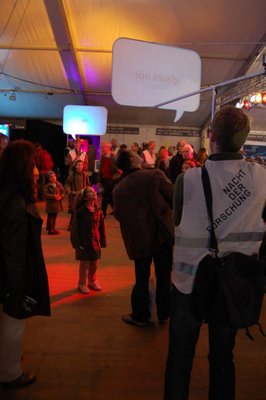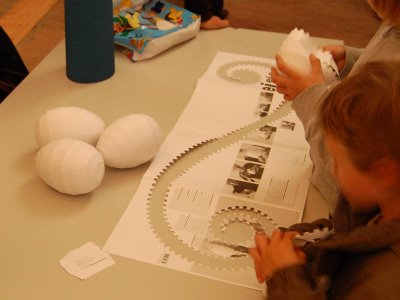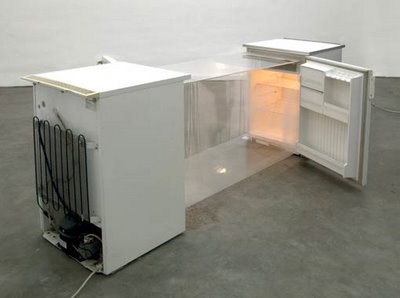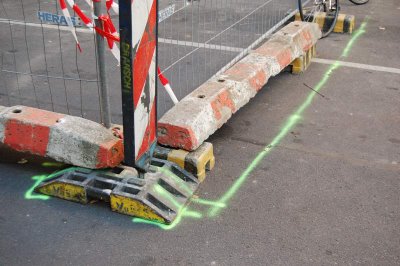Archive for September, 2008
Chat at Researchers’ Night Zurich

Zurich was great fun. The first time that I had so many kids using Chat. All pics on flickr.
Egg Egg Egg

A beautiful DIY paper craft egg model called “ei ei ei” I saw during the Researchers’ Night Zurich last week. From a perforated sheet of paper you could easily ‘click’ a perfect egg. Nice! More info (german) and a PDF download here.
Blinkenlights alive again!

A new version of the famous Blinkenlights called Stereoscope is about to get launched on city hall Toronto the next days. New technology for the ‘screen’ has been developed and an application for the iPhone is already available.
I am very curious for the interaction factor. :-)
Good luck to Tim and the team!
All news on blinkenlights.net/blog
Pic of the first test run yesterday. Looks great!
Michel de Broin

I love the works of Michel de Broin! Very good stuff!
thx for the link Jerry!
Great Encounter
Two refrigerators, Plexiglas shape
By definition a refrigerator stands alone in its corner and, withdrawn from the world, it controls its atmosphere and protects its contents. Its door must be kept closed, otherwise it looses its cool. This withdrawal explains the isolation of refrigerators.
Is it possible to envision the encounter between two refrigerators? In this installation, two solitudes unite through a canal connecting their inside worlds. This unusual encounter produces a mist on the surface that binds them together.
Urban Screens Melbourne

My good friend Mirjam is about to open the Urban Screens Melbourne festival/conference on the upcoming weekend. Looks like a promising program (Saskia Sassen etc…). If you are Downunder go there and take a look.
**********************************************************************
Urban Sreens Melbourne 2008
Public Multimedia Program: 3.-8. October 2008
Conference “Mobile Publics”: 3.-5. October 2008
http://www.urbanscreens08.net
**********************************************************************
As part of USM08, Melbourne’s central city square comes alive with an
Extensive outdoor exhibition that explores the diverse local infrastructure
of urban screens, utilized to create the atmosphere of a lively modern
public space.
USM08: Connected Communities is a free public multimedia exhibition
exploring the influence of digital moving images in public spaces utilizing
the infrastructure of Federation Square and temporary LED screens, in
selected regional Australian cities.
The exhibition is a six-day program that experiments with the programming
of a wide range of cultural content, suitable for urban screens. USM08
presents film screenings, an artistic short film program, interactive art,
audiovisual performances, projections, VJ sets, live streamings and public
remote talks.
The international program includes e.g. specific artistic night an morning
screenings, considering the issue of light and sound pollution, a special
local indigenous program, futuristic films such as Spielberg’s Minority
Report or visual thought provoking films such as Koyaanisqatsi as well as
interactive screen-based projects including Falling Times – a participatory,
news translation machine based on the universal language of signs; Seed –
whereby people receive a ‘seed’ via their mobile phone that they can grow
into a tree on the big screen; and MobiSpray – an application that allow
visitors to digitally spray paint the architectural façade, StalkShow – a
screen backback performance, dealing with the threat of insecurity and
isolation in public space or Reflections, a real-time documentary about our
emotional connection to water and urban screens experience.
USM08 has invited Melbourne-based festivals and their creative communities
to share the platform of USM08 to explore ways of inspiring the city to
modernise the use of urban screens. Selected highlights from partner events
such as the New York based Streaming Museum, Art at the Heart from Alice
Springs and Blinkenlights Stereoscope from Toronto will be broadcast live as
part of the Joint Broadcasting program.
All the info you need is on: http://www.urbanscreens08.net
contact: info@urbanscreens.net
USM08 is initiated by the International Urban Screen Association and hosted
by Fed Square Pty Ltd. The multimedia program is produced with the
assistance of the Australian Government through the Australia Council for
the Arts, its arts funding and advisory body, the conference developed in
cooperation with Melbourne University.
_______________________________________
URBAN SCREENS MELBOURNE 08
www.urbanscreens08.net
Mirjam Struppek
Artistic Director
STREET art?

(Hmm… is this an adidas street art viral?
No, fortunately not. The three stripes which behave against all traffic street signage mark out the track for the Berlin Marathon on the upcoming weekend? How about teaming up for an early little marathon during Friday afternoon traffic rush hour? ;-) Found on Torstr/Rosenthaler Platz, Berlin)
Construction Site Mark Up Language II
Public Interface Studies II

( Pin code input pad on a Deutsche Bank ATM in Berlin Prenzlauerberg.)
Hmm … isn’t that strange? It seams like everybody has a one, nine or zero in his/her four digit pin code and very few people a six or a two. Do banks have any special algorithms on generating pin codes which are simple to learn by heart? Or do we have a security issue here? Yes, true my code does not contain two, four or six. Am I in trouble now … ;-)
Essay on “Friends”
![]()
Thanks to Theo Honohan who did write an interesting essay on my latest project “Friends“.
Friends
Aram Bartholl’s workshop Friends actualizes the processes of abstraction and distancing which are involved in the construction of contemporary social networking websites. By turning these immaterial processes into physical action and representations, the work offers a critical model of current software practice on the web.
Under the general name of Web 2.0, social networking sites provide various facilities for publishing content on the web. In the case of Flickr, the content is images; in the case of Delicious, bookmarks; Last.fm, music playlists; Facebook and myspace, general personal information. The material published on these sites is often not particularly interesting to a general viewer. Its value consists primarily in the availability of information to friends. The ability to explicitly create links of friendship between users is therefore the central feature of these sites, and the feature from which the name “Social Networking” is derived.
Bartholl’s work, which could have been titled Friends?, calls into question the value and meaning of these explicit declarations of friendship. For one thing, the mechanical nature of the process gives it a simplistic quality. Two people are either friends or they are not, according to the system. This binary coding of relationships leaves no room for gradations of familiarity from intimacy to acquaintance. This initial observation is enriched by the level of detail into which the piece goes in representing the internal abstractions of a site such as Facebook. Each level of abstraction can be seen as a distancing from reality and the site of a possible slippage between image and actuality.
The process of creating a personal profile in the system begins with a digital photograph. This image of the user is transformed digitally into a black and white stencil. Affixing a printout of the stencil to a rubber stamp, the user cuts out the white areas to create a reusable stamp of their own image. In creating a reusable stamp, the work captures the infinitely reproduceable nature of a digital image. The image can appear over and over within the “site”, rather than existing just as a single original.
The creation of a profile continues with the preparation of a blank booklet for use as a register of friends. The booklet gains structure entirely through a series of rubber stamps which mimic the process of formatting a blank computer database. Data slots are created for name, email address and website, and a further grid of spaces is prepared to hold references to the user’s details on other social networking sites. The process of registering friends involves stamping, carbon-paper transfers, and the gluing of pre-prepared adhesive stamps into the “data slots”. The complexity of this process parallels the degree of indirection and formality involved in the software behind a social networking site, if not the experience of creating friends on Facebook. Bartholl, by calling attention to this complexity, illustrates the degree to which the information we share fits into an elaborate structure.
The process of adding friends to one’s personal profile is a reciprocal one; each of you ends up with a new page in the booklet showing the details of your new friend. The piece has another component, however, a central volume which includes a page for each user which records their friends (affixed as stamps) and pending friend requests (unglued stamps are held in a plastic pouch.) The analogy here is with a central database on a system such as Facebook. The whole graph of relationships is held in one place, rather than being stored in private, personall relations between profiles/booklets. This central volume is of course the way social networking systems are actually implemented, while the “peer-to-peer” architecture of the booklets, while offering potential advantages in security and privacy, has not been pursued (except, to a degree, in the case of Skype.)
The presence of a central database is a reminder of the industrial scale and automation of the process. Bartholls’ work problematizes the mass production of social contacts. While the concrete formal techniques of the workshop (sheets of repeated portraits) evoke images of an artistic practice such as that of Andy Warhol’s “Factory”, the abstract structure revealed by the development of a profile and network of friends shows the potentially dehumanizing nature of social networks. The choice of black and white for all representations produces an impression of direct simplicity but also unyielding control. The idea of a computerized social network, in the end, is a formalism, while social relationships are blurry, vital and inevitably exceed the terms of any fixed representation.
23 September 2008
Game Over – Video
I was not allowed to embed this nice video but fortunately I know how to write in hyper text markup language. When you click with your mouse pointer at the following uniform resource locator adress starting with hypertext transfer protocol your web browser (A web browser is a software application which enables a user to display and interact with text, images, videos, music and other information typically located on a Web page at a website on the World Wide Web or a local area network.) will hyperlink you automatically to the movie. Isn’t that great? (Next time I ll explain what YouTube is.)
http://de.youtube.com/watch?v=Ovvk7T8QUIU
Sorry for waisting your time. ;-)
